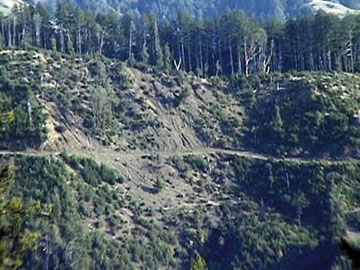 Canada's stock market has often been referred to as market of rocks and trees, a reference to it's reliance on commodities like minerals, lumber and oil to power its economic growth and stock markets.
Canada's stock market has often been referred to as market of rocks and trees, a reference to it's reliance on commodities like minerals, lumber and oil to power its economic growth and stock markets.I have written recently about the bell ringing in the US, my opinion that the market is near the top for the stock market, based on a number of signs I see, not the least of which is unrealistic expectations of capital gains (note, things have only gotten more speculative since this was written), rising interest rates, booming commodity prices (a harbinger of inflation, something particularly bad for the US market), risky assets becoming more popular (note, things have only gotten more speculative since this was written), while quality assets languish (i.e. big cap's continue to be available for bargain prices). All of this common sense information makes me also wonder if another 1972-1974 drop might be in the offing, and if so, can one "hide out" successfully in the Canadian hard asset climate, as Sir John Templeton is reported to have done in the secular bear market lasting from 1968 to 1981.
Culling through the TSE (Toronto Stock Exchange - Canada's largest stock exchange, now renamed as the TSX) statistics, if you were focused on avoiding the 1972-1974 bear market, the escape to Canada wouldn't have provided much comfort. The Dow fell by about 40-45% over that time, and the TSE also fell, by a somewhat similar amount. In 1972, the TSE index closed the year at 1226 (its monthly high close for the year), and by December 1974, closed at 835, a decline of 32%. So over the short term, the two markets were fairly similar.
However, over a slightly longer period, it was definitely favorable to be in the Canadian market, as by mid-1979 it had rallied to double in value over it's 1974 close, while the Dow took until 1982 to close above the 1000 level at year end; this was a level it (the Dow) first pierced in 1964 and closed at year end above that in 1972. Perhaps because inflation was such a factor, companies involved in hard assets (mining, lumber, oil) were the prime beneficiaries of hard asset inflation, and thus the Canadian market rallied through the mid-to-late 1970s. This is a scenario that I think is could again be replicated when the US market softens over the next while and struggles over the period thereafter.
I had always thought that the Canadian market had fared better than the US market during the brutal 1970s bear market. It turned out I was both right and wrong.

JW
The Confused Capitalist
Support this blog and our advertisers: check out the advertised listings.
PS: Changes made, May 3 06, 3:20PM, to correct grammer and erroneous reference to 1972 TSE "low close", when it should have stated "high close".
No comments:
Post a Comment